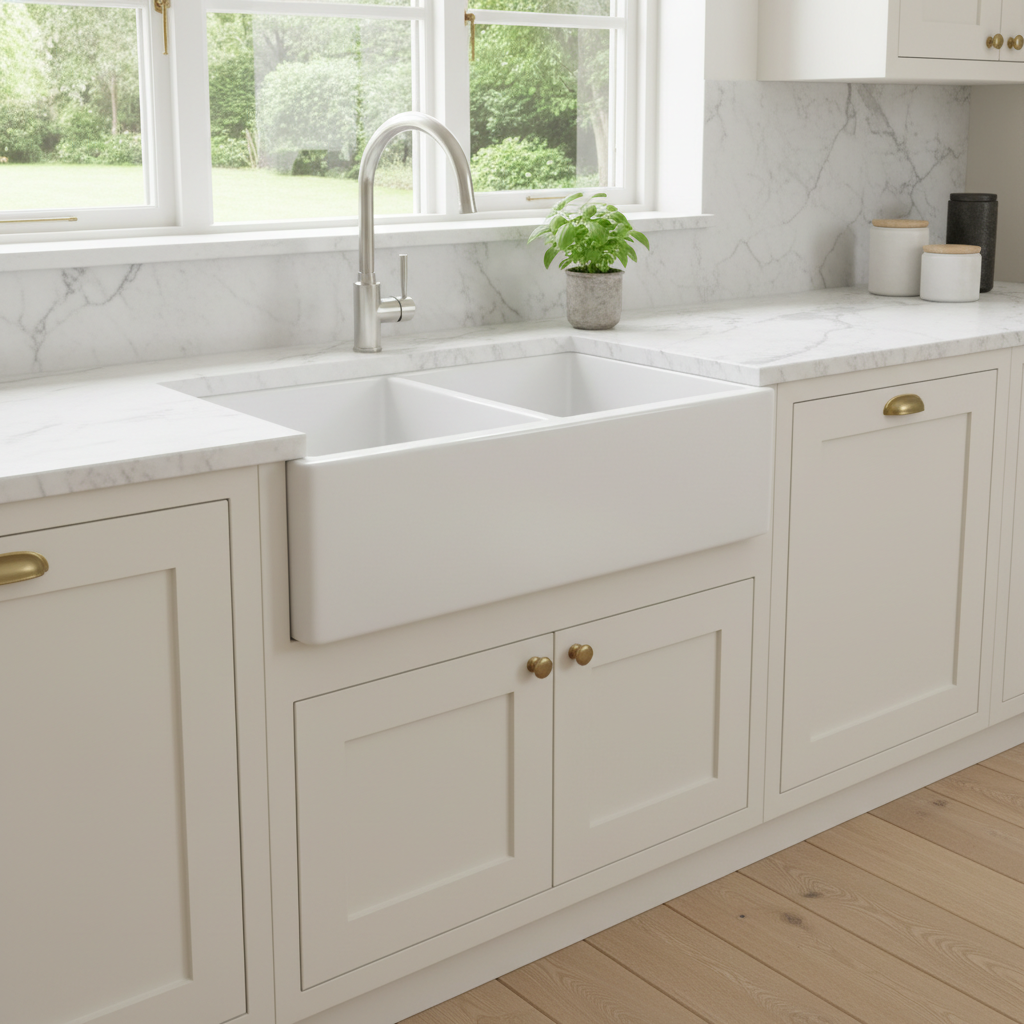You’ve seen them in magazines, on Pinterest, and probably dreamt about having one in your own kitchen: the beautiful, deep, apron-front farmhouse sink. It’s a timeless piece that adds so much character and functionality. But then the thought hits you: “Don’t I need to tear out my entire kitchen for that?” The good news is, for many of us, the answer is a resounding NO! You absolutely can install a farmhouse sink without undertaking a full-blown kitchen remodel. It takes some plaing, a bit of elbow grease, and the right approach, but it’s totally achievable.
I remember when I first started looking into it. My kitchen cabinets were perfectly fine, my countertops were relatively new, and the thought of a complete demolition was just too much. But that gorgeous farmhouse sink kept calling my name. I dove deep into research, watched countless videos, and decided to tackle it myself. And let me tell you, the satisfaction of standing back and admiring that new sink, knowing I didn’t have to break the bank or live without a kitchen for weeks, was immense. So, if you’re in the same boat, let’s walk through how you can achieve that farmhouse charm without the chaos of a full remodel.
Why a Farmhouse Sink? It’s More Than Just Looks!
Before we dive into the “how,” let’s quickly touch on the “why.” Farmhouse sinks aren’t just pretty faces (though they definitely are!). They offer several practical benefits:
- Deep Basin: Perfect for large pots, baking sheets, or even bathing a small pet.
- Apron Front: Reduces splash back and makes leaning into the sink more comfortable, as there’s no countertop edge to hit.
- Style Statement: They instantly elevate your kitchen’s aesthetic, adding a touch of rustic elegance or modern chic, depending on the material.
So, you’re not just getting a new sink; you’re upgrading your entire kitchen experience!
Understanding the “No Remodel” Challenge (and How We’ll Tackle It)
When we say “no remodel,” we’re talking about avoiding major structural changes, replacing all your cabinets, or redoing your flooring. The primary challenge with installing a farmhouse sink into an existing kitchen lies in two main areas:
- Cabinet Modification: Standard base cabinets aren’t designed for an apron-front sink. You’ll need to cut into the face frame and potentially the side panels of your existing sink cabinet.
- Support Structure: Farmhouse sinks, especially those made of fireclay or cast iron, are significantly heavier than standard sinks. Your cabinet needs a robust internal support system.
The good news? Both of these challenges are completely manageable with the right tools and a careful approach. We’ll focus on modifying your existing sink cabinet to perfectly cradle your new farmhouse pride and joy.
Choosing the Right Farmhouse Sink for Your “No Remodel” Project
This is a critical first step! Your choice of sink will heavily influence the installation process.
- Material: Fireclay, cast iron, stainless steel, and copper are common. Fireclay and cast iron are very heavy, requiring more robust support. Stainless steel is lighter.
- Installation Type:
- Undermount: The most common and desired type, where the sink lip is mounted underneath the countertop. This typically requires precise cuts to the countertop opening.
- Drop-in (Top-mount or Self-Rimming): The sink lip rests on top of the countertop. This can sometimes be easier if your existing countertop cut-out can be slightly enlarged without looking awkward, or if you’re comfortable making a new cut. Some drop-in farmhouse sinks have shorter aprons that might require less aggressive cabinet cutting.
- Size: Measure your existing cabinet’s width and depth *very* carefully. Remember, the sink needs to fit *inside* the cabinet once the face frame is cut. Also, consider the depth front-to-back, especially if you have existing plumbing or a garbage disposal that needs space.
Pro Tip: Look for a sink that closely matches the width of your existing sink cabinet for the easiest modification. If your cabinet is 36 inches wide, try to find a 33 or 30-inch sink to leave a little breathing room, or a 36-inch sink designed to fit that exact space. Always check the manufacturer’s exact rough-in dimensions!
Gathering Your Tools and Materials
Before you start, make sure you have everything ready. Nothing is more frustrating than stopping mid-project for a forgotten tool!
- Your new farmhouse sink!
- Measuring tape, ruler, pencil, straight edge
- Safety glasses and gloves
- Jig saw or circular saw (for cabinet cuts)
- Drill and assorted drill bits
- Screwdriver (manual and/or power)
- Lumber for support frame (e.g., 2x4s or 2x6s, pressure-treated if possible)
- Wood screws (various lengths)
- Wood glue
- Shims
- Caulk gun and silicone sealant (kitchen/bath grade)
- Level
- Adjustable wrench, basin wrench (for plumbing)
- New P-trap and drain assembly (often comes with the sink or needs to be purchased separately)
- Possibly a new faucet if your old one isn’t compatible with the new sink’s hole configuration
Step-by-Step: The Installation Process
1. Preparation: Emptying and Measuring
First things first: clear everything out from under your old sink. Discoect the plumbing (water lines, drain, garbage disposal if you have one). Place a bucket under the P-trap to catch any residual water. Carefully remove your old sink.
Now, the crucial part: measuring. Measure the exact dimensions of your new farmhouse sink, paying close attention to the apron height, width, and depth. Transfer these measurements onto your sink cabinet’s face frame. Mark precisely where the new sink’s apron will sit. Remember to leave a small gap (⅛ to ¼ inch) around the sink to allow for shimming and sealant.
2. Cabinet Modification: The Critical Cut
This is where courage comes in! You’ll be cutting out a section of your cabinet’s face frame. For an undermount farmhouse sink, you typically cut out the entire false front (if your cabinet has one) and the crossbar directly below it. You might also need to notch the side panels of the cabinet if the sink is wider than the cabinet’s interior.
- Use your drill to make pilot holes in the corners of your cut lines – this helps your jig saw start cleanly.
- Carefully cut along your marked lines using a jig saw. Take your time, go slowly, and wear safety glasses!
- If your countertop is already cut for a standard sink, you may need to expand the opening. For laminate or wood countertops, you can use a circular saw or jig saw. For stone or quartz, *do not attempt this yourself* unless you are an experienced professional. Call a countertop fabricator. Many “no remodel” scenarios involve keeping the existing countertop, so choosing a sink that fits the existing opening or a top-mount sink (which can conceal minor countertop discrepancies) might be key here.
3. Building Support: Because Sinks Are Heavy!
This is non-negotiable for heavy sinks. Your new sink needs a sturdy platform to rest on. You’ll build a support frame inside the cabinet, typically using 2x4s or 2x6s.
- Measure and cut two pieces of lumber to span the depth of the cabinet, from front to back, just inside the side panels.
- Cut two more pieces to span the width, coecting the front-to-back pieces.
- Assemble these into a sturdy frame that will sit flush with the bottom of the sink’s apron, providing support for the sink’s base.
- Attach this frame securely to the cabinet’s side panels using long wood screws. You might need to add vertical supports from the cabinet floor up to this frame, depending on the sink’s weight and your cabinet’s construction.
- Use a level to ensure your support frame is perfectly flat and level both front-to-back and side-to-side. Shims can be your best friend here.
4. Dry Fit and Adjustments
Carefully place your new farmhouse sink into the modified cabinet and onto your new support structure. Don’t apply sealant yet! This is your chance to check the fit.
- Does the apron sit flush or slightly proud of the cabinet face, as desired?
- Is the sink level? Use shims if needed, placing them between the sink and the support frame.
- Is there enough clearance for plumbing at the back?
- Does it look good with your countertop?
Make any necessary adjustments to the support frame or cabinet cuts now.
5. Plumbing Discoection & Recoection
Once you’re happy with the dry fit, lift the sink out (get help if it’s heavy!). It’s usually easier to install the faucet and drain assembly onto the sink *before* dropping it into place, especially for heavy sinks. Follow the manufacturer’s instructions for your specific faucet and drain.
6. Sealing and Securing the Sink
Apply a generous bead of silicone sealant along the edges of the support frame where the sink will rest, and along the top edge where the sink meets the countertop (for undermounts) or along the rim (for drop-ins). Carefully lower the sink back into position, pressing firmly to ensure good contact with the sealant.
Some farmhouse sinks come with mounting clips or brackets. If yours does, install them now according to the manufacturer’s instructions to secure the sink to the countertop or cabinet. Tighten them firmly, but don’t overtighten and crack the sink.
7. Faucet Installation and Final Plumbing
Coect your faucet’s water supply lines. Recoect the drain assembly and P-trap. If you have a garbage disposal, install that now as well, coecting it to the sink and the drain.
8. Testing for Leaks
Turn your water supply back on slowly. Run water into the sink, filling it up a bit, then pull the stopper and let it drain. Carefully inspect all coections – under the sink, around the P-trap, and around the garbage disposal – for any leaks. Tighten coections as needed. It’s wise to place a dry towel or paper towels under the coections to easily spot any drips.
Tips for a Smooth Installation
- Measure three times, cut once: Seriously, precision is key here.
- Get help: Farmhouse sinks are heavy. Don’t try to lift it alone.
- Watch videos: Seeing the process in action can be incredibly helpful.
- Don’t rush: This isn’t a race. Take your time with each step.
- Safety first: Always wear safety glasses when cutting or drilling.
- Patience: You might encounter unexpected challenges. A deep breath and a cup of coffee often solve many problems.
When to Call a Pro
While installing a farmhouse sink without a full remodel is very DIY-friendly for cabinet modification, there are times when professional help is a good idea:
- Stone Countertops: If your existing granite, quartz, or marble countertop needs to be cut or altered significantly, call a professional countertop fabricator. This is not a DIY job unless you have specialized tools and expertise.
- Complex Plumbing: If your plumbing setup is unusually complex or you’re not comfortable working with water lines, a plumber can ensure everything is leak-free and up to code.
- If you’re unsure: If at any point you feel overwhelmed or out of your depth, it’s always better to call in a professional than risk damaging your new sink or your kitchen.
Conclusion
Installing a farmhouse sink without tearing down your entire kitchen is not just a dream – it’s a perfectly achievable home improvement project. With careful plaing, precise measurements, and a willingness to get your hands a little dirty, you can transform your kitchen and enjoy the timeless beauty and practicality of a farmhouse sink. It’s a project that offers tremendous satisfaction, knowing you’ve brought that magazine-worthy look into your home on your own terms. So go ahead, measure twice, cut once, and enjoy your stuing new kitchen centerpiece!




